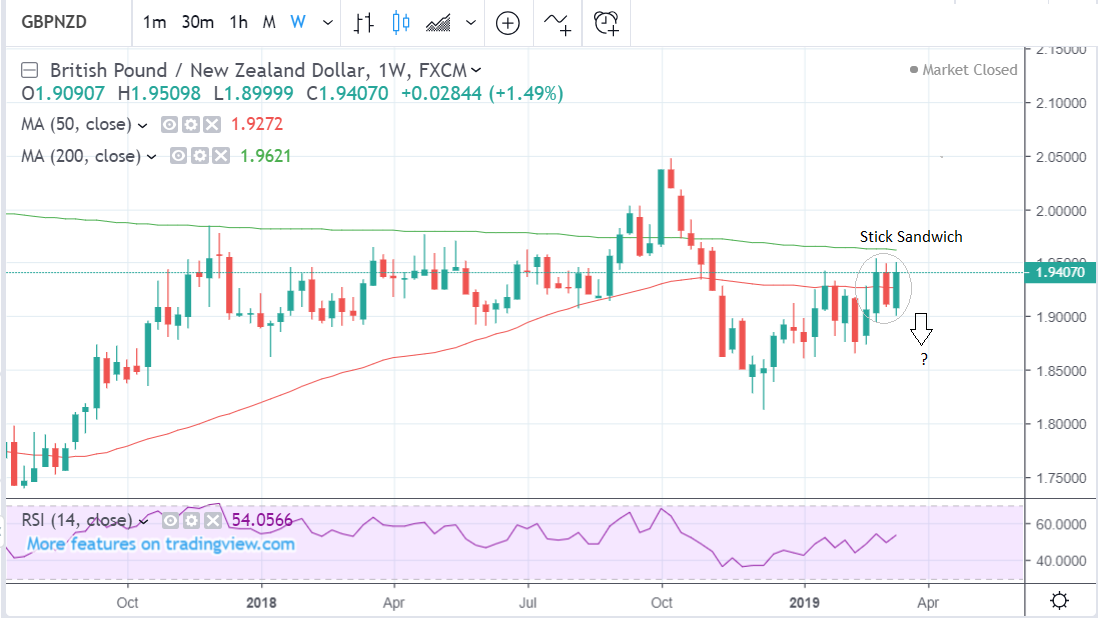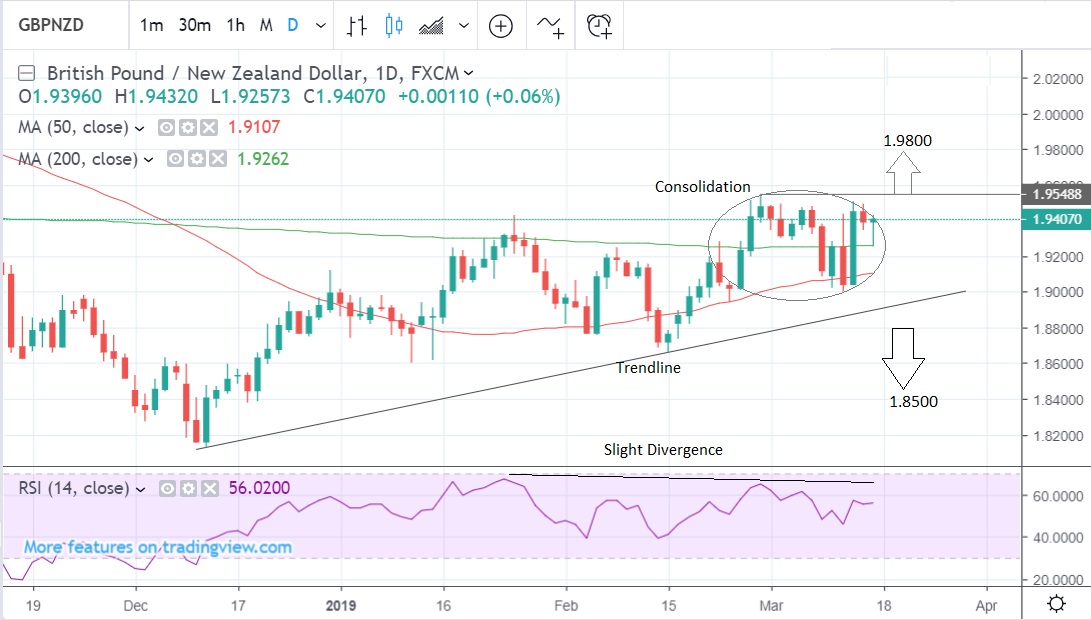The Pound-to-New-Zealand-Dollar Rate in the Week Ahead: Mixed Signals Coming from Charts

© Adobe Stock
- GBP/NZD showing mixed signals on different timeframes
- Weekly chart giving off bearish signals, daily charts bullish
- Brexit vote main event for theGBP as NZD eyes GDP data
The Pound-to-New-Zealand-Dollar rate is to begin trading around 1.9105 Sunday after falling more than -1.5% in the previous week although the outlook for the pair is clouded, given mixed signals coming from the charts.
The Pound rose against most rivals as a result of the option of a ‘no-deal’ Brexit being taken off the table. UK Parliament first voted to reject Theresa May’s deal again, then rejected the possibility of a hard-Brexit, and finally approved an extension to article 50, which could mean Brexit is delayed.
The technical outlook is mixed. Longer-term charts are giving off bearish warning signs but shorter-term charts suggest the nascent uptrend remains intact and that it will continue for a while yet.

Above: Pound-to-Kiwi rate shown at weekly intervals.
The ‘stick sandwich’ Japanese candlestick pattern on the weekly chart is bearish and indicates a bias to a reversal lower. It is composed of three bars, the outer two of which are green up bars and the middle one is a red down bar.
The outer two should ideally envelop the middle one like a sandwich. The example on GBP/NZD is quite close to ideal. It suggests a reversal lower.
The close location of the 200-week Moving Average (MA) just above the exchange rate provides a tough ceiling of resistance which bulls will find difficult to break above and may even prompt a reversal - this further enhances the bearish tenor of the longer-term chart

Above: Pound-to-Kiwi rate shown at daily intervals.
The daily chart is less obviously bearish. It shows the pair in a steady uptrend ever since the December lows, and this uptrend is expected to continue rising because, as the adage goes, ‘the trend is your friend’.
More recently the pair has been consolidating in a sideways range, which could be a volatile broadening pattern but is overall too messy to categorise.
As such, a break above the February highs and the 200-week MA, confirmed by a move above 1.9700 would probably lead to a continuation higher to a target at 2.000 eventually.
Alternatively, assuming the bearish signals on the weekly charts come good, the pair could weaken and a move below the trendline and the 1.8800 level would probably signal such a decline, with a downside target, then, at probably 1.8500.
New Zealand Dollar: What to Watch
The main data releases for the New Zealand Dollar (Kiwi) include the current account and overall economic growth (GDP).
The current account deficit is forecast to narrow to -3.49bn NZ Dollars in Q4 from -6.15bn previously when it is released at 21.45 GMT on Tuesday. Generally a narrower current account deficit would be expected to be supportive of the currency since it governs gross inflows and outflows.
GDP data for Q4 is out at the same time on Wednesday and is forecast to show growth of 0.6% from 0.3% previously. The higher the growth rate, the stronger the currency, so a surprise increase would appreciate the Kiwi and vice versa for as surprise lower.
Other fundamental news events which are most likely to influence the New Zealand Dollar (Kiwi) are probably those related to China, which is the largest single importer of New Zealand (NZ) products.
The signing of a trade deal between the U.S. and China would eliminate one major headwind for the Kiwi and is currently the more probable outcome according to most analysts.
There is more of an incentive for both superpowers to make a deal because it is economically in their best interests. This is especially the case given the growing U.S. trade deficit due to falling exports to China.
Treasury secretary Steven Mnuchin recently said that they had made a “lot of progress” in trade talks but did not reveal any details and said, quoting President Trump, that it was more important to get “the right agreement and not rush it” than any deal. This suggests a breakthrough in talks may take longer than a week.
A further positive development in China’s trade relationship with the U.S. was that it passed a law at the National People’s Congress on Friday which addresses specific issues the foreign business community has long complained about, such as intellectual property protection.
Critics of the law, however, have said that although it is a step in the right direction it does not go nearly far enough and was unlikely to be a game-changer in securing a quick trade deal with the U.S.
The Pound: What to Watch
The main fundamental driver for the Pound in the week ahead is probably developments in the Brexit process, with the Bank of England (BOE) meeting on Thursday also likely to cause volatility.
It is highly likely that the government will try, for the third time, to get its Brexit deal approved by Parliament, or failing that, that the EU will require a lengthy delay of article 50.
The latest reports from Brussels are suggesting the EU may try to make a delay conditional on either the UK having a second referendum, a general election or a very firm plan.
It is suggested this may focus minds, especially amongst Brexiteers who could fear a hijacking of Brexit if there is a delay. This will put pressure on them to accept the government’s negotiated deal.
The two most likely scenarios, therefore, are that Theresa May’s deal finally gets approved on a third attempt, or that Brexit is delayed on the condition of a referendum or general election being held.
Both would be very positive for the Pound, which compliments the overall bullish technical outlook.
The BOE meeting on Thursday, at 12.00 GMT, could also impact on Sterling. There is a risk the BOE may change its statement to reflect the recent slowdown in the economy. If so the Pound is likely to suffer.
Up until now, it had been assumed Brexit risks were the only thing stopping the BOE from raising interest rates, but the slowing economy may be providing them with other reasons not to.
“The economy has no doubt slowed but the Bank seems unwilling to shift to a more dovish stance, reasoning that it should just be patient for now as an ‘orderly’ Brexit outcome can dispel much of the uncertainty by itself and hence, kickstart investment and growth. Overall, the BoE is unlikely to deviate much from this stance, but if there is any change, it’ll probably be towards a more cautious bias,” says Raffi Boyadjian, an economist at XM.com.
From a purely hard data perspective, the main releases are employment data out on Tuesday, inflation data out on Wednesday and retail sales on Thursday.
Labour market data is expected to continue showing signs of strength, when released on Tuesday at 9.30. The unemployment claimant count is expected to have risen by only 2.7k in February - a relatively low count - the unemployment rate is forecast to be stuck at a historic low of 4.0% in January, and overall payroll count to have risen by 120k in December, according to consensus estimates.
More important for Sterling, perhaps, is average earnings in January, since this has more influence over Bank of England (BOE) policy.
If average earnings rise more than the 3.4% in January (3.2% including bonuses) that is forecast, inflation will probably rise and so will interest rates - with expectations increasing that the BOE will raise them, and this will drive Sterling higher. Higher interest rates are positive for the Pound because they attract and keep greater inflows of foreign capital.
Inflation is out on Wednesday and is another key metric for the Pound. As explained above inflation influences BOE policy which impacts on the currency. In January inflation came out surprisingly lower after falling -0.8% compared to December. If inflation is also shown to be negative in February it could really drive down the Pound. Current expectations, however, are for a 0.2% rise.
Thursday sees another major data release, in the form of retail sales in February, out at 9.30. This is forecast to show a -0.3% fall from 1.0% previously. A deeper-than-expected decline, however, could trigger more weakness for Sterling.
Time to move your money? Get 3-5% more currency than your bank would offer by using the services of foreign exchange specialists at RationalFX. A specialist broker can deliver you an exchange rate closer to the real market rate, thereby saving you substantial quantities of currency. Find out more here.
* Advertisement




